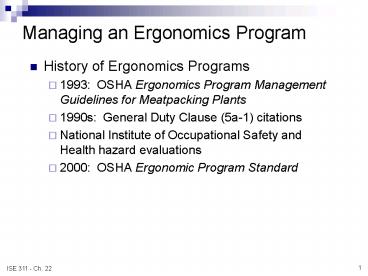Managing an Ergonomics Program - PowerPoint PPT Presentation
Title:
Managing an Ergonomics Program
Description:
Representation from production, safety, medical, human resources, maintenance, and engineering. ... Checklists. Qualitative or quantitative ... – PowerPoint PPT presentation
Number of Views:58
Avg rating:3.0/5.0
Title: Managing an Ergonomics Program
1
Managing an Ergonomics Program
- History of Ergonomics Programs
- 1993 OSHA Ergonomics Program Management
Guidelines for Meatpacking Plants - 1990s General Duty Clause (5a-1) citations
- National Institute of Occupational Safety and
Health hazard evaluations - 2000 OSHA Ergonomic Program Standard
2
Development of Ergonomic Standards
- 2001 Ergonomic Program Standard rescinded
- Currently there is no federal ergonomics
standard. - OSHA continues to apply General Duty Clause.
- Some states have workplace ergonomics standards.
- ANSI provides a voluntary standard (Management of
Work-Related Musculoskeletal Disorders)
3
The Ergonomics Program as a System
- System Goals
- To reduce or eliminate potential for disorders.
- To provide treatment to reduce effects of
disorders if they occur. - Responsibilities depend on size of facility and
manufacturing vs service. - Activities divide into
- Human resources
- Engineering and operations management
- Workers
Engineering
Management
Worker safety, health, comfort, productivity
Human Resources
Workers
4
System Components in Detail
- Engineering
- Designing, installing, and maintaining workplace
layout, work methods, tools, and equipment. - Process engineering
- Maintenance
- Product engineering
- Management
- Upper management sets goals and commits
resources. - Production supervisors
- Have familiarity with process and operators
- Are first to see problems
- Have a direct interest in efficiency and health
5
System Components (cont.)
- Human Resource Activities
- Collecting and maintaining employee information
- Occupational safety
- Medical
- Worker Compensation insurance
- Workers
- Are directly affected by ergonomics programs.
- Should be included in problem-solving efforts.
- Can suggest process improvements.
- Can detect and report symptoms of disorders early.
6
Program Elements
- Basic goal of all programs - provide an effective
work environment that - reduces unnecessary effort fatigue, potential
for musculoskeletal disorders - results in increased worker efficiency
- All programs should include some form of all of
the elements discussed in the next 8 pages. - Actual implementation depends on size and
characteristics of organization. - See, for example, box 22.1, pg. 419
7
Specifics of Program Elements
- Policies and Procedures Document
- Provides formal documentation to fulfill OSHA
requirements. - Communicates authority and accountability.
- Documents allocation of resources.
- May document improvements and accomplishments.
- See Fig 22.1, pg 420 for sample contents
- Q Review the company you created as part of
the macroergonomics discussion
8
- Ergonomics Committee
- Separate from the safety committee.
- Representation from production, safety, medical,
human resources, maintenance, and engineering. - Responsibilities include
- Assist in prioritizing recommendations.
- Maintain documentation.
- Ensure periodic reviews of the ergonomics effort.
- Q Discuss how your company will incorporate
documentation an ergonomics committee
9
- Proactive Measures
- Integrate ergonomics into the workplace at the
early stages of process design. - Engineers must understand ergonomic implications
of designs. - Organizations can provide feedback to vendors.
- Worker Involvement
- Formal (ergonomics committee) informal
(suggestion system) - Can suggest improvements and point out hazards.
- Provide feedback to the worker who makes a
suggestion. - Workers can help document effects of
modifications. - Q What proactive measures can you take?
10
- Identification of Problem Jobs Through
Surveillance - Passive health surveillance
- Reviews of OSHA 300 logs (fig. 22.2 or
www.osha.gov) - Reviews of Workers Compensation insurance files
- Active health surveillance
- Ergonomics surveys of workers
11
- Identification of Problem Jobs Through Job-Site
Analysis - Uses observations, interviews, and measurements
to address existing operations - Goal - make recommendations to improve process as
a whole - Approaches
- Mathematical models (e.g., NIOSH lifting
equations) - Checklists
- Qualitative or quantitative
- Can save time, be used without significant
technical understanding. - USE WITH CARE! (Can misrepresent task
requirements.) - Narrative
12
- Methods of controlling WMSDs (work-related
musculoskeletal disorders) - Administrative controls
- structuring workers jobs to reduce exposure to
hazards - Engineering controls
- modifying workplace design, equipment, and tools
- Work-practice controls
- addressing correct methods of performing tasks
- Q What controls will you institute?
13
- Training
- Basic categories
- Signs and symptoms that indicate MSD might be
developing - Job-related risk factors associated with risk of
disorders - Procedures for addressing disorders, if they
occur - Emphasis depends on audience
- Affected workers
- Production management
- Engineering maintenance
- Health care providers
- Ergonomics committee
14
- Medical Management
- Prevention of disorders or disabilities through
early detection and treatment. - Have individual workers understand early symptoms
and report when they occur. - Have health care providers tour the facility and
understand task characteristics. - Document and Evaluate the Program
- Periodically review documentation.
- Keep an ergonomics casebook.
- Prioritize proposed modifications.
- Follow up and evaluate to determine effectiveness
of modifications.































